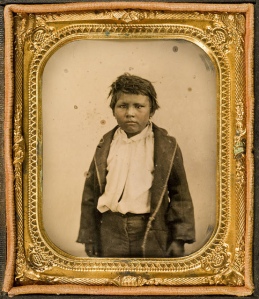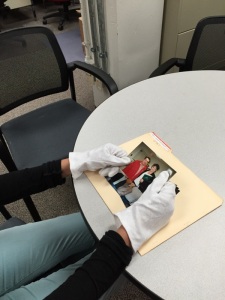Photographs are one of the most commonly archived material in personal and community archives, and require some special care and handling for their long-term preservation. Digital photography is similar to other digital files, addressed in another post. Digital photographers should be aware of the problem of proprietary software based on camera brands, for example, many raw files are not in widely accepted formats and cannot be considered a preservation format. Photographers should look closely at the format recommendations in the digital files post.
Analog photography has a long history, and it is possible that you may encounter formats that are unusual, and perhaps printed on glass (ambrotype and glass plate negatives) or metal (tintype or daguerreotype).
![Ambrotype of Mea-to-sa-bi-tchi-a, or Smutty Bear By Thomas Easterly or John Fitzgibbons (National Museum of American History) [Public domain], via Wikimedia Commons](https://nativemediaarchives.files.wordpress.com/2015/06/mea-to-sa-bi-tchi-a_or_smutty_bear_1857.jpg?w=212&h=300)
By Thomas Easterly or John Fitzgibbons (National Museum of American History) [Public domain], via Wikimedia Commons

It is important to identify what format you have, as the preservation needs are different for formats with different types of emulsions or substrates. This guide from the Northeast Document Conservation Center gives detailed information about each type, Types of Photographs.
There are a few general guidelines for handling photographs. You should protect them from heat and light, and be particularly mindful of the relative humidity (35-50%), since photographs are sensitive to changes in humidity. Color photographs are more stable at a cold temperature, so if you have access to a colder area that would benefit the newer color photographs.
The emulsion of a photograph should never be touched with bare hands, as fingerprints can leave oil that cause damage. If you do not have a pair of clean cotton gloves or disposable gloves to use, make sure to only touch the back and paper sides of the photograph.

It is best to minimize handling if possible. If a photograph needs to be handled regularly, you can encase it in a Mylar sleeve, available in a variety of sizes at Gaylord Archival Supplies. It is also recommended to storage photographs in folders so you can see what you have without pulling anything out and in boxes to protect from dust and debris.
It is important to never use glue, staples, tape or to place photographs in albums that compromise the integrity of the photographic paper. Albums should be made with archival acid free paper, and always use photo corners to hold the photographs. Mats are a good option for high value photographs or anything you would like to display.
For more information on analog photography:
Storing Photographic Prints-National Archives
Care, Handling and Storage of Photographs-Library of Congress
A Short Guide to Film Base Photographic Materials: Identification, Care, and Duplication-NEDCC
